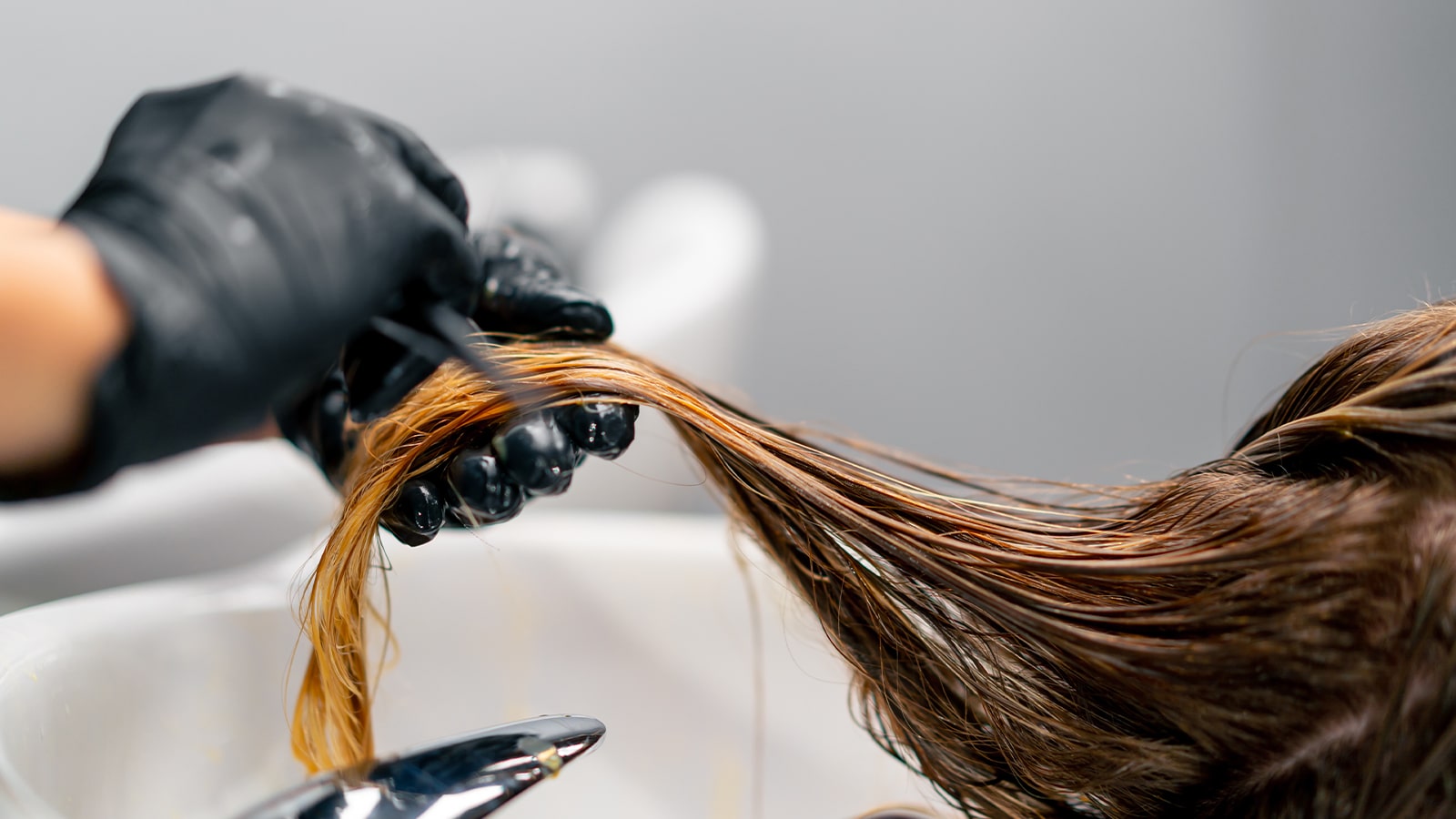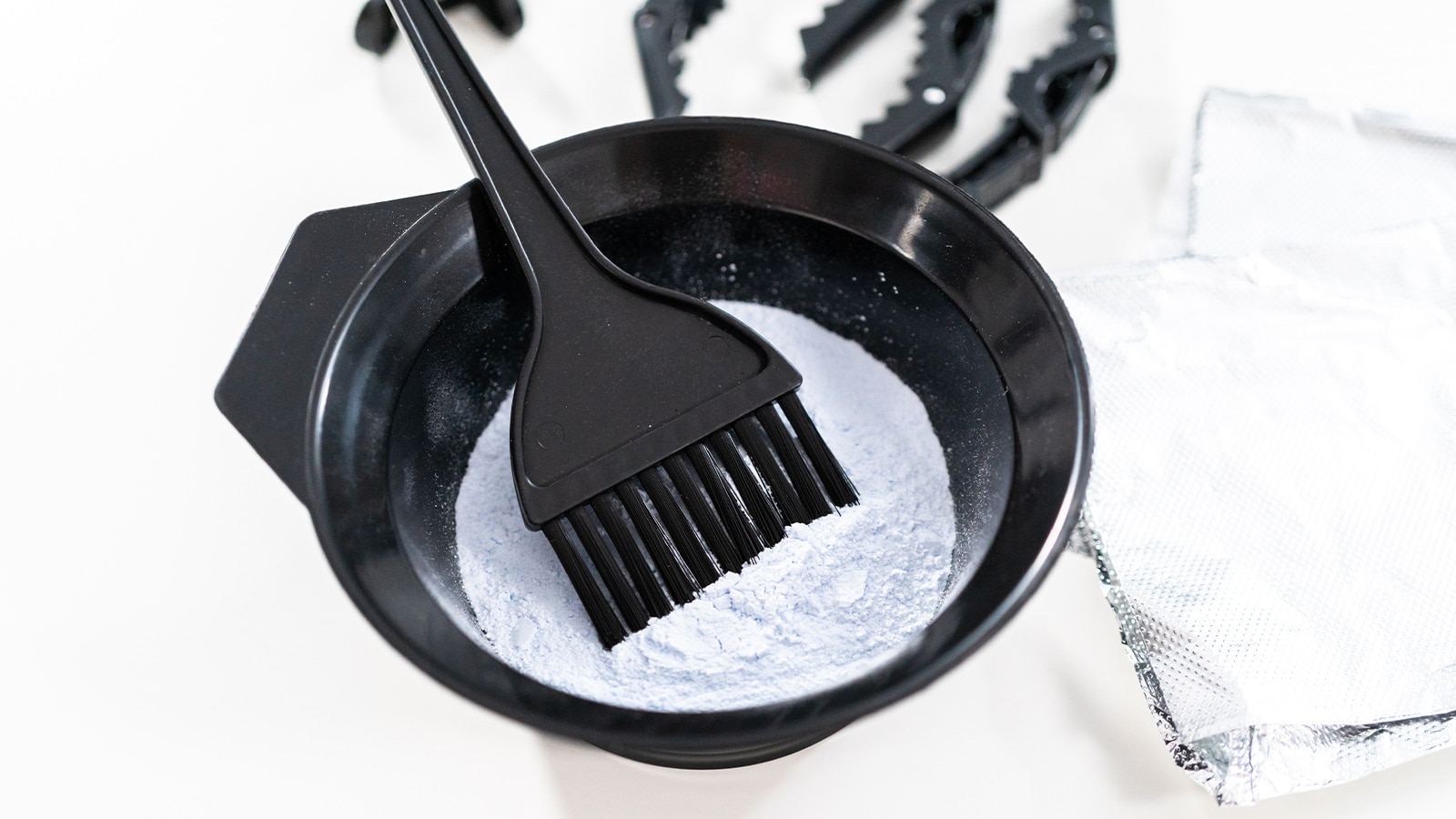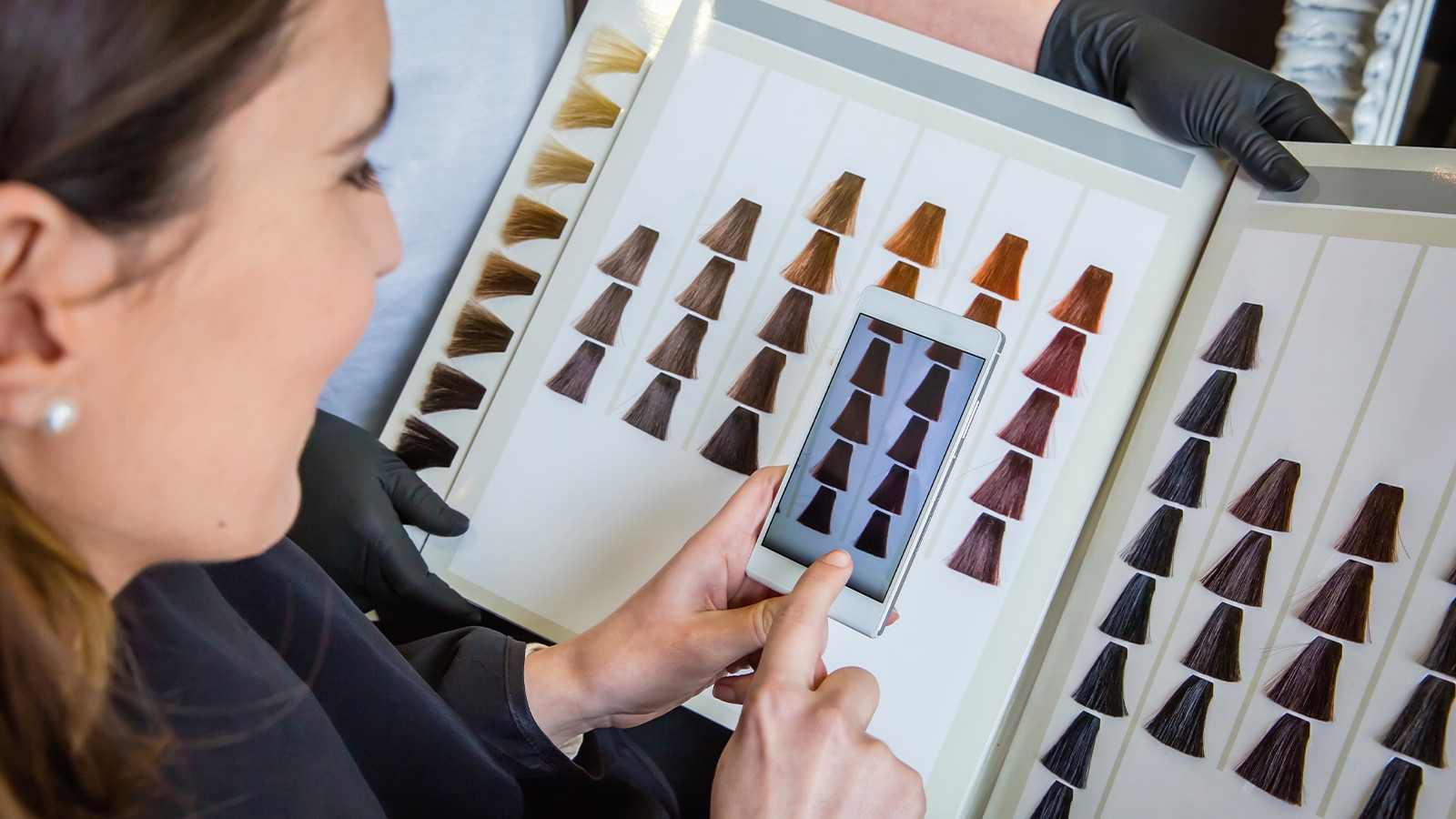 February 7, 2025 | Hair Color
February 7, 2025 | Hair Color
Hair coloring is more than just a beauty ritual; it’s a complex chemical process that transforms the very structure of your hair to achieve that perfect shade. Whether you’re opting for a subtle balayage, vibrant highlights, or a bold winter color trend, understanding the science behind hair coloring can help you make informed decisions and maintain the health of your hair. At Trademark Salon, we take pride in using cutting-edge techniques and premium products to ensure that your hair looks and feels its best. Here’s a deep dive into what happens during the hair coloring process and how you can get the most out of your salon visit.
-
Anatomy of Hair: The Foundation of Coloring
To fully appreciate how hair coloring transforms your look, it’s essential to understand the anatomy of your hair. Each strand of hair is made up of three distinct layers, each playing a crucial role in how hair dye interacts with your hair:
- Cuticle: The cuticle is the hair’s protective outermost layer, composed of overlapping cells much like shingles on a roof. It shields the inner layers from environmental damage and moisture loss. In the hair coloring process, the cuticle must be opened to allow dye molecules to penetrate into the cortex. This step is critical, as the success of the coloring process depends on how effectively the cuticle layer is lifted.
- Cortex: The cortex lies beneath the cuticle and is the thickest part of the hair shaft. It contains keratin (a structural protein) and melanin, the natural pigment responsible for your hair color. The melanin in the cortex determines whether your hair is black, brown, red, or blonde. During hair coloring, chemical agents interact directly with the melanin in the cortex to lighten, darken, or replace the existing color.
- Medulla: The medulla is the innermost layer of the hair shaft, though not all hair types have a medulla. It doesn’t play a significant role in hair coloring but can impact the hair’s overall texture and thickness.
Each layer contributes to the structural integrity of the hair, and the coloring process must be tailored to protect and enhance these layers. At Trademark Salon, we use products and techniques designed to maintain the health of your hair while delivering vibrant, lasting color.
-
The Science of Hair Dye: Permanent vs. Semi-Permanent
Hair dyes are categorized into permanent and semi-permanent, with each type offering distinct benefits and applications. The science behind these dyes lies in how they interact with your hair’s natural pigment and structure.
Permanent Hair Color
Permanent hair dye is ideal for those seeking long-lasting results and significant changes in hair color. It relies on a robust chemical process that alters the hair’s structure:
- Cuticle Opening: The process begins with ammonia, an alkaline agent that raises the hair’s pH, causing the cuticle to open. This step is essential to allow the dye to penetrate the deeper layers of the hair shaft.
- Melanin Lightening: Hydrogen peroxide, also known as the developer, reacts with the natural melanin in your hair, breaking it down and lightening the hair. This step ensures the new color can fully develop, especially if you’re going lighter than your natural shade.
- Color Molecule Bonding: The dye molecules penetrate the cortex, where they undergo chemical reactions to form larger molecules. These larger molecules become trapped inside the cortex, creating a permanent color that won’t easily wash out.
For vibrant, long-lasting results, we recommend our Goldwell Hair Color services, which are known for their innovative technology and superior quality.
Semi-Permanent Hair Color
Semi-permanent dyes are less invasive and perfect for experimenting with color or enhancing your natural shade. They don’t contain ammonia and only mildly open the cuticle:
- Surface-Level Color: Instead of penetrating deeply, semi-permanent dyes coat the outer layers of the hair, blending with your natural pigment to create a subtle, glossy effect.
- Gradual Fading: As these dyes don’t chemically alter the melanin, they fade gradually over a few washes, making them a low-commitment option.
Semi-permanent dyes are a fantastic choice for clients who want to try a new color without a permanent change. The process is gentler, making it suitable for those concerned about hair damage.

-
The Role of Hydrogen Peroxide and Ammonia
Hydrogen peroxide and ammonia are two key players in the hair coloring process, working in tandem to achieve your desired shade.
Hydrogen Peroxide
Hydrogen peroxide, also called the developer, serves multiple functions during hair coloring:
- Lightening the Base: It oxidizes the natural melanin in your hair, effectively lightening it. The strength of the developer, measured in volumes (10, 20, 30, 40), determines how much lifting occurs. For instance, a 10-volume developer deposits color with minimal lightening, while a 30-volume developer can lighten hair several levels.
- Facilitating Color Development: Peroxide helps activate the dye molecules, allowing them to penetrate the cortex and bond to your hair.
However, excessive use of hydrogen peroxide can weaken the hair shaft, leading to brittleness over time. At Trademark Salon, we carefully select the appropriate developer strength to minimize damage while achieving optimal results.
Ammonia
Ammonia is an alkaline chemical that plays a vital role in opening the hair cuticle:
- Cuticle Opening: By raising the hair’s pH, ammonia softens the cuticle, making it easier for the dye molecules and peroxide to penetrate the cortex.
- Color Penetration: Ammonia helps the dye interact with the natural pigment in the cortex, ensuring vibrant and even coverage.
Newer formulations often replace ammonia with gentler alternatives, reducing its strong odor and potential irritation. At Trademark Salon, we stay updated with the latest advancements in hair color formulations to provide you with a comfortable and effective experience.
-
The Balayage and Ombre Debate: A Chemical Perspective
Balayage and ombre are two of the most popular hair coloring techniques, each involving unique applications and chemical processes. While both styles deliver stunning results, understanding the science behind them can help you choose the right option for your hair goals.
Balayage
Balayage is a freehand painting technique where the color is applied directly to the hair surface without using foils. The goal is to create a natural, sun-kissed effect with a seamless blend:
- Selective Bleaching: A lightener, often containing hydrogen peroxide, is painted onto the surface of the hair, strategically avoiding the roots. This minimizes damage while creating a graduated effect.
- Minimal Cuticle Disruption: Since the application is more targeted and uses less product, the cuticle remains relatively intact, making balayage a gentler option.
For an in-depth look at balayage and its benefits, check out our article on balayage highlights.
Ombre
Ombre involves creating a gradient effect, with darker roots transitioning to lighter ends:
- Full-Length Bleaching: Unlike balayage, ombre requires bleaching larger sections of the hair to achieve the desired gradient. This often involves higher concentrations of hydrogen peroxide.
- Defined Transition: While the blending can be soft, ombre typically has a more noticeable contrast between the roots and ends, which requires precise sectioning and application.
The choice between balayage and ombre often comes down to personal preference and maintenance. Balayage offers a more natural, low-maintenance look, while ombre makes a bolder statement. Our detailed comparison of balayage vs. ombre can help you decide which style suits you best.
-
Protecting Hair During Coloring
Hair coloring is a transformative process, but it can take a toll on your hair if not done properly. Protecting your hair during and after the coloring process is essential to maintaining its health and vibrancy. At Trademark Salon, we prioritize both beauty and hair integrity, ensuring you walk out with gorgeous, healthy locks.
Pre-Color Care
Preparation is key to protecting your hair during the coloring process. A few steps can make a significant difference:
- Moisturize and Strengthen: Deep-conditioning treatments a week before your appointment help fortify your hair. These treatments infuse moisture and strengthen the cuticle, which can minimize damage during coloring.
- Clarify but Don’t Overwash: A gentle clarifying shampoo can remove product buildup, but avoid over-washing before your appointment, as natural oils protect your scalp and hair.
In-Salon Protective Techniques
At Trademark Salon, we use products and techniques designed to minimize damage:
- High-Quality Developers and Dyes: We rely on trusted brands like Goldwell to ensure our hair colors are not only vibrant but also enriched with protective ingredients.
- Olaplex or Bond-Building Additives: These products work to rebuild broken bonds in your hair during the coloring process, reducing brittleness and breakage.
- Gentle Application: Our stylists carefully apply color to avoid overlapping on already-colored sections, which can lead to unnecessary damage.
Post-Color Care
Once your hair is colored, proper aftercare is critical:
- Hydrate Regularly: Use hair masks or leave-in conditioners weekly to restore lost moisture.
- Avoid Heat: Reduce the use of hot tools to prevent further stress on your hair. If you must use them, always apply a heat protectant.
- Choose Color-Safe Products: Use sulfate-free shampoos and conditioners specifically designed for color-treated hair. For more tips, explore our guide on maintaining hair color between salon visits.

-
Hair Color Trends and Seasonal Tips
Hair color trends are ever-evolving, influenced by fashion, celebrities, and even the changing seasons. Staying on top of these trends ensures your hair remains a statement of your personal style.
Winter Hair Colors
During the colder months, deeper, richer hues tend to take center stage. Shades like espresso brown, burgundy, and icy blonde are particularly popular. These colors not only complement the season but also add depth and dimension to your look. Check out our top picks for winter hair colors to inspire your next transformation.
Spring and Summer Shades
As the weather warms up, lighter and brighter shades make their appearance. Think honey blondes, beachy balayage, and pastel tones like rose gold or lavender. These shades reflect the playful, sunlit vibes of spring and summer.
Year-Round Color Considerations
While trends can guide your choice, it’s also essential to consider what suits your skin tone and lifestyle. For example:
- Cool Tones: Ash blonde or icy brown shades work well for cooler undertones.
- Warm Tones: Caramel, copper, and golden hues flatter warmer undertones.
At Trademark Salon, we’ll help you find a color that matches both the season and your unique style. If you’re unsure about which technique to choose, explore the differences between balayage and ombre to find the best fit for your desired look.
-
Table: Chemical Components of Hair Dyes and Their Functions
| Chemical | Function | Impact on Hair |
| Ammonia | Opens the cuticle for color penetration | Can cause dryness if overused |
| Hydrogen Peroxide | Oxidizes melanin and lightens natural pigments | Weakens the hair shaft over time |
| Dye Precursors | Form large color molecules inside the hair cortex | Creates long-lasting color |
| Conditioning Agents | Protect and smooth the hair | Enhances shine and texture |
-
Maintaining Color-Processed Hair
After coloring your hair, maintenance is the key to keeping your shade vibrant and your strands healthy. With proper care, you can extend the life of your color and prevent premature fading or damage.
Daily Care Routine
- Wash Strategically: Use shampoos and conditioners formulated for color-treated hair. Sulfate-free options are a must, as sulfates can strip the color and leave your hair dry.
- Limit Washing: Washing your hair two to three times a week is ideal. On non-wash days, dry shampoo can help maintain freshness.
- Cool Water Rinse: Always rinse your hair with cool or lukewarm water. Hot water opens the cuticle and allows color to escape, causing fading.
Deep Conditioning Treatments
Coloring can leave your hair dry, so regular deep-conditioning treatments are essential. These products replenish lost moisture and help repair any damage caused by chemical processes. For those looking to enhance hair health and growth, explore our guide on how to grow your hair faster.
Protect Against Environmental Stressors
The sun, chlorine, and pollution can all impact your hair color:
- UV Protection: Use hair products with UV filters to shield your color from fading due to sun exposure.
- Swim Smarter: Before swimming in chlorinated pools, wet your hair and apply a leave-in conditioner to reduce absorption of harmful chemicals.
Salon Touch-Ups
Regular salon visits are necessary to maintain your color. For permanent hair dye, touch-ups every 4-6 weeks can keep your roots looking fresh. For balayage or other low-maintenance techniques, spacing appointments further apart may be sufficient. When it’s time for a refresh, we’ll help you stay on trend with techniques like balayage highlights tailored to your needs.
Conclusion: Embrace the Transformation
Hair coloring is a fascinating blend of art and science, and at Trademark Salon, we’re here to guide you through every step of the process. Understanding the chemical interactions involved can empower you to make informed decisions and care for your hair post-coloring. Ready to book your transformation? Visit us today and let us help you achieve the hair of your dreams!
By incorporating science-backed techniques and premium products, Trademark Salon ensures your hair coloring experience is not only transformative but also nurturing for your hair’s health.
